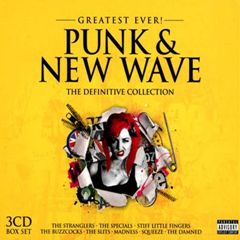Greatest Ever! Rock (2008-2015) – 2013 Punk & New Wave CD3
Greatest Ever! Rock (2008-2015) – 2013 Punk & New Wave CD3

01. Penetration — Don't Dictate 02. U. K. Subs — Warhead 03. Dead Kennedys — Holiday In Cambodia 04. Angelic Upstarts — Woman In Disguise 05. The Defects — Suspicious Minds 06. The Vibrators — Automatic Lover 07. Alternative TV — Action Time Vision 08. Lene Lovich — Say When 09. Spizzenergi — Where's Captain Kirk 10. The Crack — All Or Nothing 11. 999 — Obsessed 12. Secret Affair — Time For Action 13. After The Fire — Der Kommissar 14. The Monochrome Set — Strange Boutique 15. The Plasmatics — Butcher Baby 16. Anti — Nowhere League — I Hate People 17. Slaughter And The Dogs — Hard Day's Night 18. U. K. Subs — Drunken Sailor 19. John Cooper Clarke — Evidently Chicken Town
Punk Rock returned rock & roll to the basics -- three chords and a simple melody. It just did it louder and faster and more abrasively than any other rock & roll in the past. Although there had been several bands to flirt with what became known as punk rock -- including the garage rockers of the '60s and the Velvet Underground, the Stooges, and the New York Dolls -- it wasn't until the mid-'70s that punk became its own genre. On both sides of the Atlantic, young bands began forsaking the sonic excesses that distinguished mainstream hard rock and stripping the music down to its essentials. In New York, the first punk band was the Ramones; in London, the first punk band was the Sex Pistols. Although the bands had different agendas and sounds -- the Ramones were faster and indebted to bubblegum, while the Pistols played Faces riffs sloppier and louder than the Faces themselves -- the direct approach of the bands revolutionized music in both the U.K. and the U.S. In America, punk remained an underground sensation, eventually spawning the hardcore and indie-rock scenes of the '80s, but in the UK, it was a full-scale phenomenon. In the U.K., the Sex Pistols were thought of as a serious threat to the well-being of the government and monarchy, but more importantly, they caused countless bands to form. Some of the bands stuck close to the Pistols' original blueprint, but many found their own sound, whether it was the edgy pop of the Buzzcocks, the anthemic, reggae-informed rock of the Clash, or the arty experiments of Wire and Joy Division. Soon, punk splintered into post-punk (which was more experimental and artier than punk), new wave (which was more pop-oriented), and hardcore, which simply made punk harder, faster, and more abrasive. New Wave was usually used a catch-all term for the music that directly followed punk rock; often, the term encompassed punk itself, as well. In retrospect, it's became clear that the music that followed punk could be divided, more or less, into two categories -- post-punk and new wave. Where post-punk was arty, difficult, and challenging, new wave was pop music, pure and simple. It retained the fresh vigor and irreverence of punk music, as well as a fascination with electronics, style, and art. Therefore, there was a lot of stylistic diversity to new wave. It meant the nervy power pop of bands like XTC and Nick Lowe, but it also meant synth rockers like Gary Numan or rock revivalists like Graham Parker and Rockpile. There were edgy new wave songwriters like Elvis Costello, pop bands like Squeeze, tough rock & rollers like the Pretenders, pop-reggae like the Police, mainstream rockers like the Cars, and ska revivalists like the Specials and Madness. As important as these major artists were, there were also countless one-hit wonders that emerged during early new wave. These one-hit groups were as diverse as the major artists, but they all shared a love of pop hooks, modernist, synthesized production, and a fascination for being slightly left of center. By the early '80s, new wave described nearly every new pop/rock artist, especially those that used synthesizers like the Human League and Duran Duran. New wave received a boost in the early '80s by MTV, who broadcast endless hours of new wave videos in order to keep themselves on the air. Therefore, new wave got a second life in 1982, when it probably would have died out. Instead, 1982 and 1983 were boom years for polished, MTV-radio new wave outfits like Culture Club, Adam Ant, Spandau Ballet, Haircut 100, and A Flock of Seagulls. New wave finally died out in 1984, when established artists began to make professional videos and a new crop of guitar-oriented bands like the Smiths and R.E.M. emerged to capture the attention of college-radio and underground rock fans. Nevertheless, new wave proved more influential than many of its critics would have suspected, as the mid-'90s were dominated by bands -- from Blur to Weezer -- that were raised on the music. ---allmusic.com
download (mp3 @320 kbs):
yandex 4shared mediafire cloudmailru
Zmieniony (Poniedziałek, 02 Kwiecień 2018 21:29)








